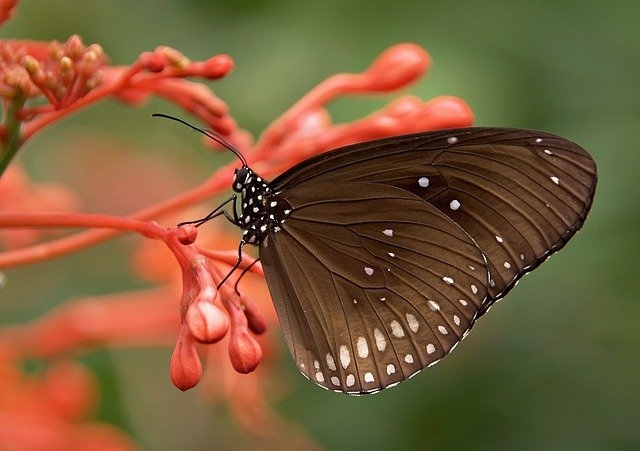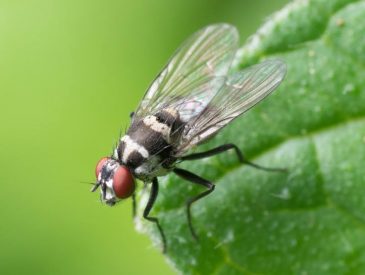How many eyes does a butterfly have? It has two eyes for adult butterflies.
The two obvious eyes on the side of the butterflies head are what is known as compound eyes. Many insects have compound eyes, which are composed of tens of thousands of tiny lenses called ommatidia instead of a single large lens.
It’s unclear whether the butterflies process these tens of thousands of images separately or combine them in their minds to form a single image. It’s an amazing achievement in either case.
Many butterflies also have simple eyes in addition to these compound eyes. Simple eyes, which are very tiny pinpricks in comparison to the large compound eyes of the adults, are what butterflies have when they are in the caterpillar stage.
This is probably the reason why so few people pay attention to the butterfly’s additional set of eyes. Simple eyes are very different from compound eyes in that they can only detect specific stimuli, like light. With these eyes, they are unable to focus, so the larger, more accurate compound lenses handle the technical work.
Table of Contents
How Many Eyes Does A Butterfly Have?
Depending on the butterfly’s stage of development, the answer to the question varies. The caterpillar stage, which emerges from the egg, has 10 to 14 (though typically 12) tiny eyelets arranged in a semicircle around the face. These very basic eyes can only distinguish between light and dark, not fine details or color. Almost entirely blind, the caterpillar uses its other senses to navigate its surroundings.
The butterfly will have two sizable, fully formed compound eyes on either side of its head when it has completed the metamorphosis process. Despite having fewer eyes than a caterpillar, the adult eyes have generally better vision. In this sense, the butterfly is hardly extraordinary. The majority of adult insects have two eyes as a standard. It’s a common misconception that insects have multiple eyes, just like spiders, crabs, and other arthropods.
The structure of the eye is what may be confusing people. The compound eye of the insect is made up of thousands of different individual photoreceptors, in contrast to the simpler lenses of most animals. Though it still functions as a single eye, each receptor in fact has its own unique cornea and lens. There may be up to 17,000 of these receptors in total in a butterfly’s eye, though many species have fewer.
The photoreceptor cells in the eye, which can distinguish between brightness and color, are another crucial part of the eye. Each butterfly photoreceptor only has a few light-sensitive cells for the light to focus on, as opposed to the many light-sensitive cells that work together to form an image in the human eye (as well as various other mechanisms to control the amount of light entering the lenses). This actually degrades the butterfly’s aesthetic appeal, but it makes up for it in other ways.
What Does The Butterfly Vision Look Like?
In comparison to the typical non-compound eye, the butterfly’s compound eye has some significant benefits and drawbacks. Its ability to see in numerous directions at once is its most significant benefit. This implies that the insect eye will maintain its fixed position, be immobile, and still have a wider field of vision than the typical animal eye. This makes it possible for a small, defenseless animal like an insect to respond almost instantly to danger.
Loss of acuity, or vision quality, is the primary drawback of a compound eye, on the other hand. The insect eye is unable to match the visual acuity of a non-compound eye with a particularly dense cell arrangement, even with many individual lenses. The acuity of the human eye is thought to be about a hundred times greater than that of even the best insect eye, which is thought to be the dragonfly’s with about 30,000 lenses per eye. The insects must move closer or farther to achieve a similar result with compound eyes because they are incapable of focusing on objects by changing the shape of the lens.
Other aspects of butterflies compensate for this lack. For instance, the butterfly’s visual repertoire includes a significant amount of color vision compared to most insects. It makes it possible for them to recognize and differentiate between the appropriate kinds of wildflowers to eat. Additionally, butterflies are faster at recognizing moving objects than people, which could be very helpful when flying. The capacity to perceive light types other than those visible to humans, such as ultraviolet and polarized light, is a crucial characteristic. While polarized light is frequently present when the atmosphere scatters sunlight in a specific way, ultraviolet light, a significant component of sunlight, is just beyond the visible blue and violet end of the color spectrum. Some insect species, including fruit flies and honeybees, have been theorized to use ultraviolet and polarized light to navigate the air while they are in flight.
The types of photoreceptors in its eye could be the secret to its wide field of vision. The human eye only has three different types of photoreceptor cells, but this is enough to see millions of different colors. Contrarily, butterflies have at least four different types of receptor cells, and many species have at least six, which allows them to distinguish certain properties of color and light that humans cannot.
Unique color vision can be found in some butterfly species. The common bluebottle butterfly’s male has 15 different types of photoreceptor cells, according to a study that was published in the journal Frontiers in Ecology and Evolution (the female was not studied, but it is likely similar). When combined with blue light, green light seemed to activate four additional receptors. Although the reason for the evolution of 15 different receptor cells is not fully understood, one theory is that it has to do with mating. The male is much better at differentiating fellow blue-colored rivals who might be challenging to spot against the blue sky because it is highly sensitive to any variation in the blue-green part of the color spectrum.

What Are The Wings’ Eyes For?
False eyespots are the term for those black spots on the wings. They are present in many butterfly species, and the small blue species of the Lycaenidae family even have fake heads with large eye spots and false antennae near the tail. Even though it is clear that these markings aren’t true eyes and cannot see, they still have many useful functions. For a long time, it was believed that these eyespots had evolved to resemble more frightening creatures’ eyes in order to deceive potential predators and make them hesitate before approaching. The idea that the eyespots divert attacks away from the head and toward more defenseless areas of the body is another viable one. These eyespots occasionally serve as secondary mate-attractors.
What Can Be Seen By Butterflies?
It may seem as though butterflies don’t need good eyesight to many of us when we watch them flitting around a garden. After all, they aren’t creating an intricate tapestry or programming a computer chip. Their only requirement is to find and consume brightly colored flowers, so their eyesight should be all they need, right?
In fact, it could be argued that butterflies’ eyes are superior to ours in many ways.
Colour
First off, butterflies have much broader color vision than humans do, including the ability to see ultraviolet. Although we are unable to see ultraviolet with the human eye, if you use specialized camera equipment to take ultraviolet pictures of a flower, you will be able to see the hidden markings that are specifically applied by the blooms to attract in pollinating insects.
The “bull’s eye” over the flower or landing lines leading up to the pollen-producing area are two examples of these markings. Overall, flowers are surprisingly direct in their requests of passing insects.
Even more intriguingly, scientists have discovered that a butterfly’s color vision varies depending on the colors they need to recognize the caterpillar’s food plant. A butterfly’s ability to use a wider spectrum means they can be sure they are laying its eggs in the proper locations if they have caterpillars that are particularly picky.
Speed
It’s amazing how much more quickly the world can move for a tiny insect. Our eyes can only see between 45 and 53 frames per second, compared to the 250 frames per second that a butterfly’s compound eyes can see.
At first glance, this superpower might seem a little pointless, but when you consider how quickly a butterfly can fly and how quickly a bird can fly, you’ll see why these tiny creatures need every advantage at their disposal to avoid getting snagged by their flapping pursuers.
Scope
The large compound eyes of an insect have an amazing field of vision compared to our eyes, which may seem obvious when you think about it.
While we are primarily only able to see what is directly in front of us, butterflies are also partially able to see above, below, and behind them. Although it is not 360 degrees, some species’ vision is thought to be around 314 degrees.
Once more, this is a perfect adaptation to evade those ravenous mouths.

How Do Butterflies See Ultraviolet Light?
Common human eyes cannot see certain wavelengths, but butterfly compound eyes can. Wavelengths of light from 254 to 600 nm can be seen by butterfly compound eyes. UV light is present in this range. Wavelengths between 450 and 700 nm are visible to the human eye.
The flicker rate of butterflies differs significantly from that of other living things, such as humans. The frame rate at which each image appears in a video on your TV can be referred to as flicker rate.
The average human flicker rate per second is between 45 and 53. A human and other animals can’t compare to butterflies’ flicker fusion rate, which is 250 times stronger and faster. This gives them a fantastic, constantly updated image.
Read about: How Many Eyes Does A Fly Have?
FAQs
How Many Eyes Do A Butterfly Have Exactly?
There are two distinct eye types in butterflies. Both single and 12000 compound eyes. The single-chambered eyes concentrate primarily on distinct objects. In contrast, they rely primarily on their 12000 compound eyes for vision.
Do Butterflies Have Ten Thousand Eyes?
Butterflies have two eyes. These “two eyes” are completely different from the human eye. … These two eyes include the single-chambered eye and the 12000 eye. A butterfly’s single-chambered eyes are primarily focused on singular or individual objects.
Are There 12,000 Eyes In A Butterfly?
Question Verified by an Expert. The insect “Monarch Butterfly” is known to have 12 000 eyes. These butterflies are the most exquisite and are regarded as the monarchs of the butterfly kingdom.
Where Are A Butterfly’s Eyes?
Some butterflies and moths have their eyespots hidden on their hindwings and will flash predators a startling glimpse of them.
Do Butterflies Have A Full-body Vision?
Some butterfly species, such as the empress Leilia (Asterocampa leilia), have a visual field of about 344 degrees on the horizontal axis, which is just 16 degrees short of being able to see all the way around their bodies. And vertically it is almost a full 360 degrees. … Visual fields are equally impressive for the majority of butterfly species.
How LongA Butterfly’s Tongue?
3.2. Proboscis morphology. The length of the proboscis of Eurybia lycisca ranges between 28.0 mm and 45.6 mm (mean 36.5 mm ± 4.1 S.D. N = 20), or roughly twice the length of the body, is shown in Table 1.
How Many Eyes Do Spiders Have?
They usually have eight eyes: two very large front eyes to get a clear colour image and judge distance and extra side eyes to detect when something is moving. The jumping spider from Australia is shown in the following image. To catch their prey, some spiders create nets.
What Is Alive With 12000 Eyes?
Butterfly – Wikipedia
12 000 eyes make up a butterfly.
Do Ants Have Eyes?
Most ants have two large compound eyes. They have a pair of simple eyes made up of numerous omatidia (eye facets) ocelli that can detect light and shadow. Ants have two antennae as well, which they use to distinguish between members of their nest and to spot potential threats.
Why Are There A Thousand Eyes On A Butterfly?
The monarch butterfly has 12000 eyes that help it to practically see in every direction. Simple and compound eyes come in two varieties on these butterflies. The single-chambered, uncomplicated eyes are used to gauge the intensity of light.
How Many Eyes Does A Cockroach Have?
Complete solution, step by step: – Cockroaches (Periplaneta) have two types of eyes simple and compound eyes. They have two sizable sessile black kidney-shaped structures on the dorsolateral sides of the head capsule in addition to three simple eyes on their forehead known as ocelli.
How Many Eyes Are There In A Bee?
FIVE eyes
When not in use, the front and back wings detach from one another to allow for simple folding. Eyes – Incredible as it may seem the honey bee has FIVE eyes two large compound eyes and three smaller ocelli eyes in the center of its head.
How Many Eyes Does A Caterpillar Have?
A caterpillar has simple, light-sensitive eyes called ocelli or stemmata that are either four, five, or six on either side, giving it a total of 10, 12, or 14 eyes.
The vision of the multiple eyes is not very good. Since they can only distinguish between light and dark due to their sensitivity to light, they serve this function.
See more about How Many Eyes Do Bees Have
Conclusion
So, how many eyes does a butterfly have? The answer is two eyes. Yes, butterflies do have eyes, but this is where it gets complicated. Looking at a butterfly’s head, it might be easy to point out their large bulbous eyes and say they have two. However, there is more to a butterfly’s vision than meets the eye.





